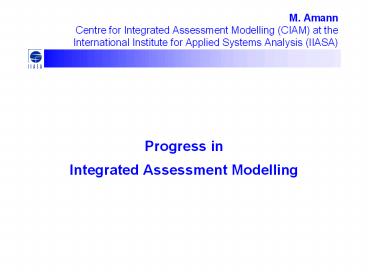Progress in Integrated Assessment Modelling - PowerPoint PPT Presentation
Title:
Progress in Integrated Assessment Modelling
Description:
Dynamic modelling of acidification ... Data for non-EU countries in the EMEP domain collected and implemented ... RAINS estimates, Non-EU countries. Integrated ... – PowerPoint PPT presentation
Number of Views:54
Avg rating:3.0/5.0
Title: Progress in Integrated Assessment Modelling
1
Progress in Integrated Assessment Modelling
- M. AmannCentre for Integrated Assessment
Modelling (CIAM) at the International Institute
for Applied Systems Analysis (IIASA)
2
Contents
- CIAM work (partly) funded by the Convention has
focused on - Baseline emission scenarios and uncertainties
- Sectoral emission trends and maximum feasible
reductions, including the potential of
non-technical measures - Integrated assessment modelling for fine
particles - Dynamic modelling of acidification
- Effects of control measures for photo-oxidants at
different scales - Effects of hemispheric pollution
- Synergies with climate change measures
3
Development of the baseline scenario
- Baseline projections developed for 25 EU
countries - For CAFE program
- Rely on PRIMES energy projections
- National projections are now collected for NEC
review - Bilateral consultations held with 104 national
experts - Data for non-EU countries in the EMEP domain
collected and implemented - Not yet validated by national experts (lack of
funding) - Uncertainties about national PM emission
inventories - Only few countries have estimated their emissions
- Sometimes large discrepancies, but mostly related
to specific sources
4
Projected PM emissions in Europe2000-2020
EU-15
EU-10
Non-EU
5
Sectoral emissions of PM2.5CAFE calculations,
EU-15
6
Sectoral emissions of PM2.5RAINS estimates,
Non-EU countries
7
Integrated assessment for PMProgress in 2004/5
- Functional relationships for regional-scale PM
formation and dispersion developed from EMEP
model - Urban increment developed for annual mean
PM2.5, based on City-delta model intercomparison - Health impact assessment for PM2.5 implemented,
reviewed by WHO/UNECE Task Force on Health - In-depth scientific peer review of RAINS
approach, financed by European Commission - Initial sensitivity analyses conducted
8
Modelling of PM2.5 ambient concentrations
- Endpoint annual mean concentrations of PM2.5
composed of - Primary emissions of PM2.5 from anthropogenic
sources - Secondary inorganic aerosols (ammonium sulfate,
ammonium nitrate) due to precursors SO2, NOx, NH3 - Water associated with secondary inorganics
- Secondary organic aerosols (from VOC emissions)
- Natural background (mineral, sea salt, organic
matter) - A fraction that is chemically not identified by
the measurements - Thus calculations do not reproduce complete
observed mass
- Endpoint annual mean concentrations of PM2.5
composed of - Primary emissions of PM2.5 from anthropogenic
sources - Secondary inorganic aerosols (ammonium sulfate,
ammonium nitrate) due to precursors SO2, NOx, NH3 - Water associated with secondary inorganics
- Secondary organic aerosols (from VOC emissions)
- Natural background (mineral, sea salt, organic
matter) - A fraction that is chemically not identified by
the measurements - Thus calculations do not reproduce complete
observed mass Focus on anthropogenic fraction!
9
Validation of RAINS reduced-form PM modelPM2.5
for CAFE baseline 2020 µg/m3
10
Loss in life expectancy attributable to fine
particles months
- 2020
2020 - CAFE baseline Maximum technical Current
legislation emission reductions
Loss in average statistical life expectancy due
to identified anthropogenic PM2.5Calculations
for 1997 meteorology
11
Inter-annual meteorological variability Loss in
life expectancy due to PM2.5
2003 meteorology Mean meteorology 1999
meteorology
Loss in average life expectancy (days)Due to
identified anthropogenic PM2.5Emissions of
2000 Preliminary estimates (generic treatment of
urban PM)
12
Progress on dynamic modelling of acidification
- Ongoing cooperation with CCE
- Methodologies developed for acidification of
freshwater and forest soils - Journal article on freshwater acidification
published - Collection of national data for soil modelling
ongoing - Simulation of baseline development under way
- Modelling of eutrophication not yet mature
13
Long-term trends in emissions
14
Simulated ANC concentrations in surface waters
Source Wright et al., EST (2005)
1860
1980
2000
2016
15
Multi-scale control strategies for ozone
- Scenarios for hemispheric pollution
- Cooperation with JRC
- Emission control strategies for hemispheric ozone
and radiative forcing - Paper published in ACP (Dentener et al., 2004)
- Implications on regional ozone levels
- Impact of hemispheric ozone changes on health
indicators explored with MSC-W - Documented in MSC-W report
- Response of population exposure indicators in
urban areas to regional emission controls - City-delta model intercomparison (Report under
preparation)
16
Impacts of CH4 and NOx/VOC controls on ozone and
CH4 burden
Global emission scenarios
___ Baseline ___ Max NOxNMVOC reduction
___ Max CH4 reduction ___ Max CH4NOxNMVOC
reduction
Global emission scenarios developed by
IIASA/RAINS, TM3 calculations by JRC-IES
17
Change in global mean radiative forcing2000-2030
W/m2
18
Change in background ozone between 1990 and
baseline current legislation 2020
Global emission scenarios developed by
IIASA/RAINS, TM3 calculations by JRC-IES
19
Changes in population-weighted SOMO35 ozone2000
- 2020 Current legislation 2020 Max. reduction
20
www.iiasa.ac.at/rains































